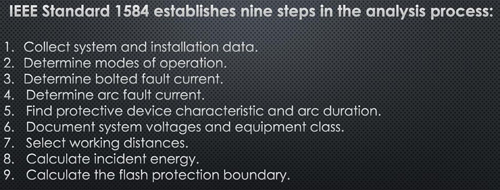Arc flash hazard analysis is essential for ensuring electrical safety and compliance with regulatory standards. Organizations can protect their workers and maintain safe and reliable electrical systems by understanding its key components, challenges, and benefits. Regular analyses, along with proper implementation of recommendations, can significantly reduce the risk of arc flash incidents and enhance overall workplace safety.
Visit Out Arc Flash Analysis/Study Training Course
What is an Arc Flash Hazard Analysis?
It is a comprehensive assessment of an electrical system to identify potential hazards associated with arc flashes. It involves calculating incident energy, determining arc flash boundaries, and recommending appropriate personal protective equipment (PPE). The goal is to ensure worker safety by minimizing the risk of shock and arc flash incidents.
Why is it Important?
This analysis is crucial for several reasons:
- Safety: It helps protect workers from severe injuries or fatalities due to arc flash incidents.
- Compliance: Ensures adherence to safety standards like NFPA 70E, which mandates such analyses.
- Risk Mitigation: Identifies arc flash hazards and provides strategies to mitigate these risks, enhancing overall workplace safety.
What are the Key Components?
The key components include:
- Data Collection: Gathering detailed information about the electrical system, including equipment specifications and protective device settings.
- Short Circuit Study: Analyzing fault current levels within the system to understand potential arc flash scenarios.
- Arc Flash Calculation: Determining incident energy levels that could be released during an arc flash.
- Arc Flash Boundary Determination: Establishing safe working distances from potential arc flash sources.
- Arc Flash Labels: Providing clear labeling on equipment with information about incident energy levels, required PPE, and safe working distances.
Who Should Perform A Hazard Analysis?
Qualified electrical engineers or safety professionals with expertise in electrical systems should conduct this analysis. These professionals must be familiar with relevant standards and regulations, such as NFPA 70E, and have experience in performing an arc flash study.
How Often Should It Be Conducted?
This analysis should be performed whenever there are significant changes to the electrical system, such as new equipment installations, modifications, or upgrades. Additionally, it should be reviewed at least every five years to ensure the analysis remains accurate and up-to-date.
What are the Steps Involved in Conducting A Risk Assessment?
A typical arc flash risk assessment follows a structured approach:
- Data Gathering: The initial step involves collecting information about the electrical system, including one-line diagrams, equipment nameplates, and short circuit study data. 2. Field Verification: Qualified personnel conduct a site survey to verify the accuracy of collected data and identify any discrepancies between existing documentation and the actual electrical system configuration.
- Arc Flash Calculation: Using the gathered data and industry-accepted methods, electrical engineers calculate the incident energy at various points within the electrical system.
- Arc Flash Boundary Determination: Based on the calculated incident energy levels, arc flash boundaries are established for different locations.
- PPE Selection: Appropriate PPE** is selected for each location based on the corresponding arc flash boundary and incident energy level. The PPE** selection ensures workers have adequate protection against potential arc flash hazards.
- Documentation and Labeling: A comprehensive report is prepared that documents the assessment findings, including calculated incident energy levels, arc flash boundaries, and PPE** requirements. Arc flash labels** are created and affixed to electrical equipment, clearly communicating the arc flash hazard level and required PPE** for safe work practices.
- Training and Communication: Workers are trained on the arc flash risk assessment findings, including PPE** requirements, safe work procedures, and the importance of maintaining arc flash boundaries during electrical work.
What are the Challenges in Performing A Risk Assessment?
Performing an arc flash risk assessment can present some challenges:
- Data Availability: Complete and accurate data on the electrical system, including equipment specifications and short circuit study results, is essential for a thorough assessment. In some cases, retrieving this data may be difficult or time-consuming.
- Complexity of Calculations: Arc flash calculations can be complex, requiring specialized software or expertise in power systems analysis. Electrical engineers with the necessary qualifications may not always be readily available in-house.
- Keeping Up with Standards: Industry standards and regulations regarding arc flash safety are constantly evolving. Keeping up with these changes and ensuring the assessment reflects the latest requirements is an ongoing challenge.
What are the Benefits of Conducting Arc Flash Risk Assessment?
Despite the challenges, the benefits of conducting an arc flash risk assessment are significant:
- Reduced Risk of Injury and Death: By identifying and mitigating arc flash hazards, employers can significantly reduce the risk of serious injuries or fatalities occurring in the workplace.
- Improved Regulatory Compliance: A comprehensive arc flash risk assessment demonstrates an employer's commitment to electrical safety and compliance with relevant industry standards and regulations.
- Enhanced Worker Safety Culture: The process of conducting an arc flash risk assessment raises awareness of electrical safety hazards among workers and promotes a culture of safe work practices.
- Reduced Insurance Costs: Demonstrating a proactive approach to electrical safety through risk assessments can lead to lower insurance premiums for employers.
How Does Arc Flash Risk Assessment Impact PPE Requirements?
An arc flash risk assessment plays a crucial role in determining the appropriate PPE** for workers performing electrical tasks. The calculated incident energy level at a specific location dictates the PPE** category and arc rating required for safe work. PPE** selection ensures workers have adequate protection against the potential severity of an arc flash incident. For example, if the calculated incident energy at a location is high, workers may require PPE** with a higher arc rating to provide sufficient protection against burns.
